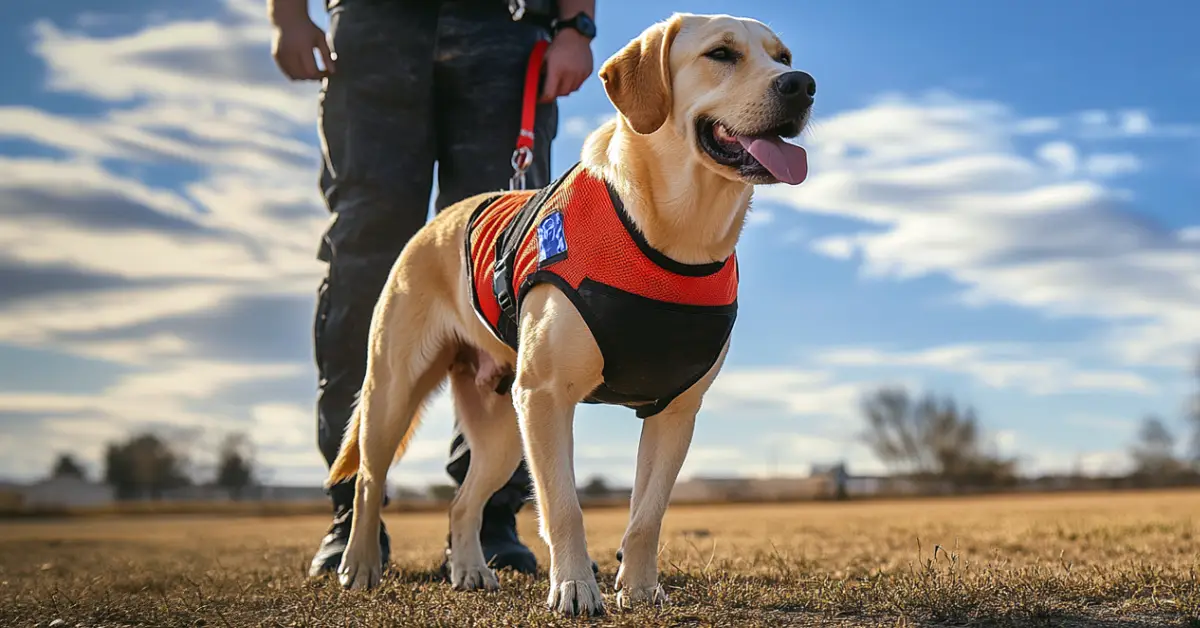How Much Does It Cost to Train a Service Dog

Training a service dog doesn’t have to break the bank! The cost ranges from free (yes, free!) to $50,000, depending on whether you choose self-training ($0 to $7,000), a hybrid approach with professional guidance ($7,000–$15,000), or full professional training ($15,000–$50,000). The price also varies based on your particular disability and the service dog tasks you need.
The good news is that you have multiple training options to fit your budget, timeline, and specific needs. This guide breaks down all the possibilities to give you an idea of what your final bill might be to train a service dog.
In this article:
- Cost of self-training your service dog
- Cost of professional service dog training
- Cost of a hybrid approach to service dog training
- Average cost per service dog skill
- Additional costs to consider
Cost of Self-Training Your Service Dog
Self-training your dog is the cheapest and maybe most rewarding approach. This route typically costs between nothing to $7,000, depending on the state you live in. How could self-training cost nothing? That’s possible if you’re an experienced service dog trainer and you don’t need any outside aids (like if you already have training guides and treats or went through a training program in the past). And yes, ADA service dog laws allow self-training service dogs without outside help.
Typically, however, self-training includes costs like essential training materials, videos, and books ($100–$5,000), task-specific training equipment ($200–$1,000), and treats and rewards for consistent positive reinforcement ($200–$800). Additional costs can include:
- Training clickers and target sticks ($10–$30)
- Travel expenses for public access training ($300–$1,000)
- Specialized harnesses and vests ($80–$300)
- Video recording equipment to review training sessions ($100–$500)
- Scent training materials for medical alert dogs ($50–$300)
- Training seminars and workshops ($200–$2,000)
- Behavioral assessments ($150–$400)
- Professional consultations for specific challenges ($75–$250 per session)
- Health clearances and temperament testing ($200–$800)
The self-training approach works really well for psychiatric service dogs because the training process helps establish a deep bond between the handler and dog to effectively recognize subtle changes in mood and respond appropriately.
Share this image on your site
Cost of Professional Service Dog Training
If you want to outsource your dog’s training to professionals, you’ll pay between $15,000 and $50,000, but you get a completely trained service animal without the stress of doing it yourself.
Here’s what that price tag actually covers: First, they can help select the perfect dog for your specific needs ($1,000–$3,000) — not every dog has the right temperament for service work! Then they’ll handle all the basic training ($3,000–$6,000) before moving on to the specialized tasks your dog needs to learn to help with your specific disability ($5,000–$30,000). Before you bring your new companion home, they’ll spend time teaching you how to work with your dog ($2,000–$5,000) and make sure everything is properly tested and certified ($500–$1,000).
The big advantage? Trainers have seen it all — they know which training methods work best for different breeds and personalities and have solutions for the challenges that might leave you frustrated for weeks. For busy people or those whose disabilities make training difficult, having experts handle everything can be worth every penny.
Cost of a Hybrid Approach to Service Dog Training
If you’re looking for a middle ground between doing it all yourself and paying for fully professional training, the hybrid approach might be perfect for you. This “best of both worlds” option can cost between $7,000 and $15,000.
Here’s where your money goes: You’ll start with professional consultations to assess your dog and create a training plan ($250–$500). Then you’ll attend group classes led by expert trainers ($30–$80 per class, usually taking 15–30 classes total) and mix in some one-on-one private sessions ($90–$180 per hour for about 10–20 sessions). For the specialized tasks your dog needs to learn for your specific disability, you’ll get expert guidance ($2,000–$5,000), plus all the training gear you’ll need ($500–$1,000).
Why do many people love this option? You get professional help without the premium price tag of full-service training. You’re actively involved in training your dog, which creates an amazing bond between you. And having trainers guide you means you won’t waste weeks going down training dead ends or teaching behaviors incorrectly that you’ll need to fix later. You learn from experts while doing the hands-on work yourself, like having a personal trainer at the gym versus trying to figure everything out from YouTube videos!

Average Cost Per Service Dog Skill
Different service dog tasks require varying levels of training time and expertise. Here’s a breakdown of common skills and their associated estimated training costs if you’re working with a trainer:
| Skill | Training Hours | Average Cost (at $150–$250/hr) |
|---|---|---|
| Basic obedience and public behavior | 30-50 hours | $4,500-$12,500 |
| Retrieval of items | 10-15 hours | $1,500-$3,750 |
| Mobility assistance (bracing, balance) | 20-30 hours | $3,000-$7,500 |
| Medical alert training (seizure, diabetes) | 40-60 hours | $6,000-$15,000 |
| Guide work for visual impairment | 120-200+ hours | $18,000-$50,000 |
| Psychiatric response tasks | 25-40 hours | $3,750-$10,000 |
| Deep pressure therapy | 8-12 hours | $1,200-$3,000 |
| Medication reminders | 5-10 hours | $750-$2,500 |
Basic obedience and public behavior training typically requires 30-50 hours of professional work, costing between $4,500–$12,500 at rates of $150–$250 per hour. Simple task training, like the retrieval of items, needs approximately 10–15 hours, while more complex skills like mobility assistance for bracing and balance support require 20–30 hours.
The more sophisticated medical alert training for conditions like seizure or diabetes detection demands 40–60 hours of specialized training, with costs ranging from $6,000 to $15,000. Psychiatric response tasks typically need 25–40 hours, while comfort-oriented skills like deep pressure therapy might require 8–12 hours. Simpler assistance like medication reminders can be taught in roughly 5–10 hours.
The most intensive training is required for guide work supporting visual impairment, demanding 120–200+ hours of highly specialized instruction and practice, with costs ranging from $18,000–$50,000. This explains why guide dogs are typically among the most expensive service animals to train properly.
Additional Costs to Consider
Don’t forget about the day-to-day expenses of having a service dog. These ongoing costs can add up to $2,000–$5,000 per year, depending on your dog’s size, breed, and specific needs.
Food will run you about $400–$700 yearly (bigger dogs eat more, and premium foods cost more). Vet care is another big expense at $700–$2,000 per year for regular checkups, vaccinations, preventative medications, and the occasional illness. Remember, keeping your service dog in top health isn’t optional — they’re working animals who need to be at their best!
When you first get your service dog, you’ll spend $200–$500 on special equipment like harnesses, ID cards, and service vests. Many handlers also budget $300–$800 yearly for pet insurance (smart move — an unexpected $3,000 surgery could sideline your helper when you need them most). Don’t forget grooming costs of $300–$1,200 yearly — service dogs need to look and smell clean, especially in public places like restaurants and hospitals.
One expense people often overlook: ongoing training! Setting aside some money yearly for “maintenance training” helps keep your dog’s skills sharp and addresses any new challenges. Think of it like tune-ups for your car — regular maintenance prevents bigger problems down the road!
About the Author: The writing team at Service Dog Certifications is made up of folks who really know their stuff when it comes to disability laws and assistance animals. Many of our writers and editors have service dogs themselves and share insights from their own experiences. All of us have a passion for disability rights and animals.
Latest Posts

Dangerous Materials Hiding in Your Dog Products
Jake’s German Shepherd began developing strange rashes around his collar. Three vet visits later, they figured out the leather was treated with chromium — a chemical that irritates sensitive skin. Jake had no idea his dog’s collar contained industrial chemicals. Most dog owners don’t know what goes into the products they buy. Many companies use […]

Read More

Can You Bring a Service Dog to a Basketball Game?
Yes, you absolutely can bring your service dog to basketball games. Whether you’re heading to your local high school tournament, a packed college rivalry game, or splurging on NBA tickets, the Americans with Disabilities Act protects your right to be accompanied by your service dog anywhere the public can go. When you arrive, venue employees […]

Read More

Best Pet Health Insurance Providers
If you own a pet, you know how important — and expensive — vet care can be. One way to offset those costs is to purchase pet health insurance. Like typical health insurance, pet insurance is available at many price points, and can cover all, most, or only some of your vet-related costs. It can […]

Read More

